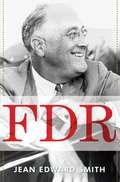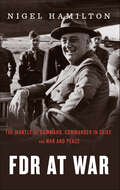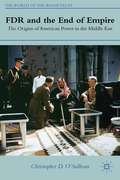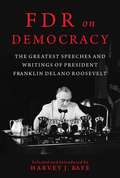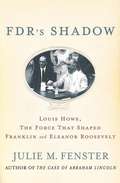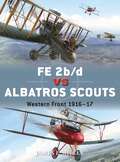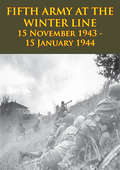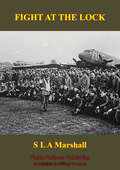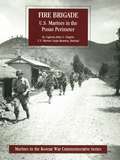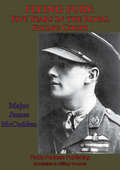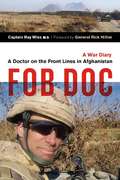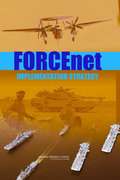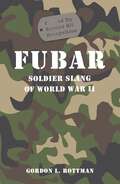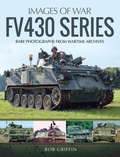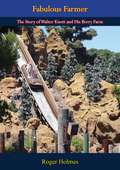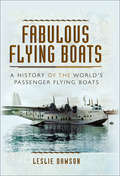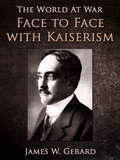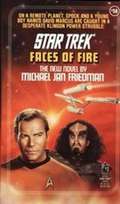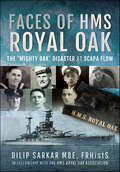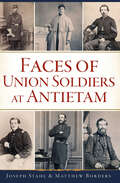- Table View
- List View
FDR
by Jean Edward SmithOne of today's premier biographers has written a modern, comprehensive, indeed ultimate book on the epic life of Franklin Delano Roosevelt. In this superlative volume, Jean Edward Smith combines contemporary scholarship and a broad range of primary source material to provide an engrossing narrative of one of America's greatest presidents.This is a portrait painted in broad strokes and fine details. We see how Roosevelt's restless energy, fierce intellect, personal magnetism, and ability to project effortless grace permitted him to master countless challenges throughout his life. Smith recounts FDR's battles with polio and physical disability, and how these experiences helped forge the resolve that FDR used to surmount the economic turmoil of the Great Depression and the wartime threat of totalitarianism. Here also is FDR's private life depicted with unprecedented candor and nuance, with close attention paid to the four women who molded his personality and helped to inform his worldview: His mother, Sara Delano Roosevelt, formidable yet ever supportive and tender; his wife, Eleanor, whose counsel and affection were instrumental to FDR's public and individual achievements; Lucy Mercer, the great romantic love of FDR's life; and Missy LeHand, FDR's longtime secretary, companion, and confidante, whose adoration of her boss was practically limitless. Smith also tackles head-on and in-depth the numerous failures and miscues of Roosevelt's public career, including his disastrous attempt to reconstruct the Judiciary; the shameful internment of Japanese-Americans; and Roosevelt's occasionally self-defeating Executive overreach. Additionally, Smith offers a sensitive and balanced assessment of Roosevelt's response to the Holocaust, noting its breakthroughs and shortcomings.Summing up Roosevelt's legacy, Jean Smith declares that FDR, more than any other individual, changed the relationship between the American people and their government. It was Roosevelt who revolutionized the art of campaigning and used the burgeoning mass media to garner public support and allay fears. But more important, Smith gives us the clearest picture yet of how this quintessential Knickerbocker aristocrat, a man who never had to depend on a paycheck, became the common man's president. The result is a powerful account that adds fresh perspectives and draws profound conclusions about a man whose story is widely known but far less well understood. Written for the general reader and scholars alike, FDR is a stunning biography in every way worthy of its subject.From the Hardcover edition.
FDR At War: The Mantle of Command, Commander in Chief, and War and Peace (Fdr At War Ser. #3)
by Nigel HamiltonThe definitive biography of FDR’s leadership during WWII, presented here in a single volume—”splendid . . . the memoir Roosevelt didn’t get to write” (New York Times Book Review).This groundbreaking, three-volume study of President Roosevelt’s role as Commander in Chief tells the story of World War II from his perspective. Using hitherto unpublished documents and interviews, Hamilton rewrites the famous account of Allied strategy given by Winston Churchill in his memoirs. Hamilton reveals, close-up and in dramatic detail, Roosevelt’s mastery of strategy, his vision, and how he overcame resistance from Churchill and his own generals to set the course for victory. Mantle of Command, Commander in Chief, and War and Peace have been celebrated as “masterly” (The Wall Street Journal).“A first-class, lens-changing work.” —James N. Mattis, former US secretary of defense
FDR and the End of Empire: The Origins of American Power in the Middle East (The World of the Roosevelts)
by Christopher D. O’SullivanBased upon extensive archival research in Great Britain, the United States, and the Middle East, including sources never previously utilized such as declassified intelligence records, postwar planning documents, and the personal papers of key officials, this is painstakingly researched account of the origins of American involvement in the Middle East during the Presidency of Franklin D. Roosevelt. It explores the effort to challenge British and French power, and the building of new relationships with Iraq, Iran, Saudi Arabia, Egypt, and the Levant states. It also reveals new and controversial discoveries about Roosevelt's views on Palestine, his relations with Middle East leaders, and his often bitter conflicts with Churchill and de Gaulle over European imperialism. Modern-day parallels make this story compelling for followers of current events, World War II, Franklin Roosevelt, the Middle East, or British imperialism.
FDR on Democracy: The Greatest Speeches and Writings of President Franklin Delano Roosevelt
by Harvey J. KayeFrom One of the Greatest Leaders in American History, a Collection of the Words and Writings that Inspired a Generation of Americans to Become the Greatest Generation In just under three decades of public life, Franklin Delano Roosevelt rose to become one of the greatest orators and leaders in American history. As the longest-serving US president, he guided the nation through two of the greatest challenges of the twentieth century—the Great Depression of the 1930s and the Fascist threat of the 1940s—and radically transformed American public life. In doing so, FDR created the conditions that enabled Americans to make the United States stronger, more prosperous, and more democratic than ever before for generations to come. Through his words—selected, annotated, and introduced here by writer and scholar Harvey J. Kaye—we rediscover the liberal and social-democratic vision and promise that FDR articulated so powerfully. We recall Roosevelt's efforts to redeem the challenge of the Declaration of Independence and renew the promise of equality and life, liberty, and the pursuit of happiness. We see him empower working people and make life more secure for more Americans. And we are reminded of his desire to not simply win the Second World War, but to create a nation and a world committed to the realization of the Four Freedoms—freedom of speech and worship, freedom from want and fear—indeed, to enact here in the United States a Second Bill of Rights, an Economic Bill of Rights for all Americans. In this collection of his greatest writings and speeches, we encounter the words that inspired and encouraged Americans to remember who they were and what they were capable of accomplishing—the words that helped turn a generation of Americans into the Greatest Generation. Now more than ever, we need to recall FDR's words. Now, when FDR's democratic legacy—the legacy of a generation—is under siege, we need to remind ourselves of who we are and what we need to do to make America freer, more equal, and more democratic.
FDR's Ambassadors and the Diplomacy of Crisis
by David MayersWhat effect did personality and circumstance have on US foreign policy during World War II? This incisive account of US envoys residing in the major belligerent countries - Japan, Germany, Italy, China, France, Great Britain, USSR - highlights the fascinating role played by such diplomats as Joseph Grew, William Dodd, William Bullitt, Joseph Kennedy and W. Averell Harriman. Between Hitler's 1933 ascent to power and the 1945 bombing of Nagasaki, US ambassadors sculpted formal policy - occasionally deliberately, other times inadvertently - giving shape and meaning not always intended by Franklin D. Roosevelt or predicted by his principal advisors. From appeasement to the Holocaust and the onset of the Cold War, David Mayers examines the complicated interaction between policy, as conceived in Washington, and implementation on the ground in Europe and Asia. By so doing, he also sheds needed light on the fragility, ambiguities and enduring urgency of diplomacy and its crucial function in international politics.
FDR's Shadow: Louis Howe, the Force That Shaped Franklin and Eleanor Roosevelt
by Julie M. Fenster"FDR's Shadow" is a brilliant look at how the indomitable and enlightened Louis Howe became the mega-advisor of the Roosevelt Clan. A must read for anybody interested in U. S. political history. --Douglas Brinkley, author of "The Wilderness Warrior. "
FE 2b/d vs Albatros Scouts
by James Miller Jim LaurierWorld War I aerial combat went through periods of alternating aerial superiority based on technology leaps. Sopwith Camels, Fokkers, and Spads became famous because they dominated later in the war, but this was an ongoing cycle for years. In the spring of 1916 the deployment of the RFC's FE 2 - with its rotary engine 'pusher' configuration affording excellent visibility for its pilot and observer, and removing the need for synchronized machine guns - helped wrest aerial dominance from Imperial Germany's Fokker Eindecker monoplanes, and then contributed to retaining it throughout the Somme battles of that fateful summer. However, by autumn German reorganization saw the birth of the Jagdstaffeln (specialised fighter squadrons) and the arrival of the new Albatros D scout, a sleek inline-engined machine built for speed and twin-gun firepower. Thus, for the remainder of 1916 and well into the next year an epic struggle for aerial superiority raged above the horrors of the Somme and Passchendaele battlefields, pitting the FE 2 against the better-armed and faster Albatros scouts that were focused on attacking and destroying their two-seater opponents. In the end the Germans would regain air superiority, and hold it into the following summer with the employment of their new Jagdgeschwader (larger fighter groupings), but the FE 2 remained a tenacious foe that inflicted many casualties - some of whom were Germany's best aces (including 'The Red Baron').
FIFTH ARMY AT THE WINTER LINE 15 November 1943 - 15 January 1944 [Illustrated Edition]
by AnonIllustrated with 28 maps and 35 Illustrations.THE WINTER LINE operations, lasting from 15 November 1943 to 15 January 1944, continued the Allied campaign to drive the Germans out of southern Italy. The underlying plan was to keep pressure on the enemy and, if possible, to break through toward Rome. Both the terrain and the season reduced the chances for effecting a breakthrough. By maintaining pressure, however, the Allies would prevent the Germans from, resting and refitting the tired and depleted divisions which they might hold as a mobile reserve for the close defense of Rome in the event of a new Allied landing on the west coast or for use in a possible counteroffensive in the opening months of 1944. Then too, the fighting in Italy had its effects on the over-all military situation in Europe. As long as the Germans were actively engaged on the Italian front, they would be forced to feed in men and supplies which would otherwise be available for the war in Russia or for strengthening their Atlantic Wall against an expected Allied invasion in 1944. Continuation of the Italian campaign was not in question; the problem was how best to carry it on.The Allied effort was therefore maintained in an offensive planned to break the enemy's Winter Line, a series of well-prepared positions along the shortest possible line across the waist of Italy-from the Garigliano River on the west through mountains in the center to the Sangro River on the east. For the individual soldiers of the Fifth Army, the attack resolved itself into the familiar pattern of bitter fighting from hill to hill.
FIGHT AT THE LOCK [Illustrated Edition]
by Colonel S. L. A. MarshallIncludes 6 mapsAs the tens of thousands of American troops began their approach toward the forbidding German-defended Normandy coast, their comrades in the 82nd and 101st Airborne divisions had already flown over the Channel and began dropping and gliding into enemy territory. The Airborne Divisions had a role critical to the success of the entire Normandy Landings; beyond the initial beach landing areas were miles of flooded defended ditches and waterways. If the German troops managed to defend these bottlenecks the Americans on Utah Beach, at the extreme right of the operation, would be unable to move forward and might have foundered on the beach..."According to plan, the D Day objectives of the 501st Parachute Infantry Regiment were well concentrated. After dropping into Normandy a little to the north and east of the city of Carentan, the regiment was to press south and westward and establish the defensive position in this direction. In detail, it was to secure the line of the lower Douve River, first by seizing the strategic lock on the Canal De Vire Et Taute at Le Barquette and then by blowing the river bridges..."From the beginning, American attention was directed at the Le Barquette lock. This unique objective and its possible military application appears to have fascinated the imaginations not only of those who planned Operation Neptune but of the commanders who were to execute it. To get to the lock first and to make certain that the enemy would have no use of it became an overriding consideration with the planning and tactical forces. American apprehensions as to what might happen if the Germans gained control of the lock superinduced one of the boldest strokes of the Normandy campaign, a stroke boldly made and tactically productive. Yet whether the emphasis placed on the position by the Allied planners was justifiable was never confirmed by the attitude of the enemy."
FIRE BRIGADE: U.S. Marines In The Pusan Perimeter [Illustrated Edition] (Marines In The Korean War Commemorative Series #4)
by Captain John J. Chapin USMCIncludes over 30 maps, photos and illustrations.The Battle of Pusan Perimeter was a large-scale battle between United Nations and North Korean forces lasting from August 4 to September 18, 1950. It was one of the first major engagements of the Korean War. An army of 140,000 UN troops, having been pushed to the brink of defeat, were rallied to make a final stand against the invading North Korean army, 98,000 men strong.UN forces, having been repeatedly defeated by the advancing North Koreans, were forced back to the "Pusan Perimeter", a 140-mile (230 km) defensive line around an area on the southeastern tip of the Korean Peninsula that included the port of Pusan. The UN troops, consisting mostly of forces from the Republic of Korea (ROK), United States and United Kingdom, mounted a last stand around the perimeter, fighting off repeated North Korean attacks for six weeks as they were engaged around the cities of Taegu, Masan, and P'ohang, and the Naktong River. The massive North Korean assaults were unsuccessful in forcing the United Nations troops back further from the perimeter, despite two major pushes in August and September.North Korean troops, hampered by supply shortages and massive losses, continually staged attacks on UN forces in an attempt to penetrate the perimeter and collapse the line. However, the UN used the port to amass an overwhelming advantage in troops, equipment, and logistics, and its navy and air forces remained unchallenged by the North Koreans during the fight. After six weeks, the North Korean force collapsed and retreated in defeat after the UN force launched a counterattack at Inchon on September 15. The battle would be the furthest the North Korean troops would advance in the war, as subsequent fighting ground the war into a stalemate.
FIRE POWER IN THE LAB: Automation in the Fight Against Infectious Diseases and Bioterrorism
by Scott P. Layne Tony J. Beugelsdijk C. Kumar N. PatelToday's world poses a triple threat to the American population: infectious diseases, contamination of food and water, and bioattacks (biowarfare or bioterrorism). At least 17 countries are producing weapons of mass destruction using viruses, bacteria, or their toxins. AIDS, E. coli contamination, drug-resistant tuberculosis, and virulent flu strains are perhaps the best known of a host of disease threats. What these dangers have in common is the amount of data required to achieve solutions; in some cases, as much as a petabit (1 followed by 15 zeros) of data is required to study large numbers of samples from widespread locations.Firepower in the Lab examines how the nation can combat this triple threat by improving our ability to detect, measure, and monitor harmful biological agents. It explores the potential of today's exciting new laboratory automation and computer technologies as well as the emerging tools of molecular biology--how we can generate and analyze more data quickly and reduce human hands-on involvement, which inevitably introduces errors.The book discusses how to improve and apply technologies such as robotics, laboratory automation, "lab-on-a-chip," bioinformatics, and Internet control innovations. It reviews lessons learned from our experience with pandemic flu viruses. It also presents strategies for developing new high-throughput technologies, including how to address the lack of public funding for critical research undertakings.
FLYING FURY: Five Years In The Royal Flying Corps [illustrated Edition]
by James Thomas Byford McCudden VC DSO & Ba, MC & Bar MMIllustrated Edition - contains 30 photosThe highest scoring British Air Ace reveals his daily life at the front, in the air and in combat with the Germans above the Western Front.In the muddy trenches of the Western front few rankers would have considered that they would achieve field rank of major and international celebrity. In the skies above the shell-torn landscape, any man with enough talent, daring and skill could hope to become a 'Flying Ace' by claiming five or more victories over enemy aviators. Such an adventurous warrior was James McCudden; born in 1895 in Kent, he enlisted in the Royal Engineers in 1910 as soon as he could. But he was smitten with the service in the air after a flight in his brothers plane in 1913 and transferred to the Royal Flying Corps. However he was only an engineer in 1914, but once in France despite his modest rank he was allowed to go up with his squadron and act as an observer in a two seater plane. After much good service as an observer his superiors put him forward for pilot training in 1916.McCudden's tally of the enemy over the next two years would rank him among the greatest of the World War One Aces; he claimed some 57 enemy aircraft even three in a single day in 1918. His exploits in the air were legendary, surviving an attack by the Red Baron himself, he pioneered new tactics that enabled him the edge of his enemy by using his engineering skill to fine tune his aircraft. He was awarded the Victoria Cross, DSO with Bar, MC with Bar and a Military Medal and the French Croix de Guerre for his daring, bravery and skill. It is with a sad irony that it was not his German foe that eventually ended his outstanding military service but a flying accident in 1918. He was only 23 at the time.His own exploits, adventures, tactics and escapes are best left to him in his own words, but suffice to say despite his modest retelling of his life in a day-by-day fashion remains both dramatic and engaging.
FOB Doc
by Ray WissMilitary doctors serving in Afghanistan usually spend their entire tour in the relatively safe confines of the main base. FOB Doc is the story of one Canadian doctor who spent nearly his entire tour in combat. Captain Ray Wiss was stationed at Forward Operating Bases - FOBs - in Khandahar province, the birthplace of the Taliban and the most intense zone combat in Afghanistan. He shares the 'terror and boredom' of the front-line soldier's life in this candid personal diary. One day, he might be participating in combat operations, treating severe and bloody injuries and coping with the deaths of fellow soldiers, both Afghans and NATO allies; another day, he might be writing about the challenges of going to the latrine in sub-zero weather. FOB Doc is heartbreaking and hilarious, often on the same page.
FORCEnet: IMPLEMENTATION STRATEGY
by National Research Council of the National AcademiesThe National Academies Press (NAP)--publisher for the National Academies--publishes more than 200 books a year offering the most authoritative views, definitive information, and groundbreaking recommendations on a wide range of topics in science, engineering, and health. Our books are unique in that they are authored by the nation's leading experts in every scientific field.
FRISCO'S KID: Frisco's Kid Everyday, Average Jones (Tall, Dark and Dangerous #3)
by Suzanne BrockmannNew York Times and USA TODAY bestselling author Suzanne Brockmann has thrilled audiences with her Tall, Dark and Dangerous series. Experience it here with a hero who must face the most daring adventure of all—falling in love.His body may heal, but his heart is another story…Being a Navy SEAL is more than a career to Alan "Frisco" Francisco—it's his whole identity. But when a severe injury threatens Frisco's ability to function in combat, he's determined to achieve a full recovery.But the unexpected appearance of his abandoned niece leaves Frisco with little time for anything but dealing with the five-year-old girl. He knows even less about parenting than he does about how to mend his broken body. And there's no way he's going to accept offers of help from his interfering neighbor, Mia Summerton. He doesn't need anyone s help. Not to care for his niece, not to accept his limitations and certainly not to fall in love.
FUBAR: Soldier Slang of World War II
by Gordon L. RottmanHumorous, sarcastic, sober, pessimistic, fatalistic, defiant or defeatist, slang is an important part of every soldier's vocabulary. Much of the slang of World War II was handed down from World War I and earlier conflicts. These words were so ingrained into the soldier's vocabulary that their use was continued by a new generation of soldiers and by the end of the war some terms had even passed into standard everyday usage. This book is a detailed survey of the slang of WWII as used and evolved by US, German and Commonwealth fighting men and women. It lists hundreds of these distinctive and evocative words with their definitions and origins, but and also includes contemporary cartoons and images, transporting the reader back through the decades into the world of the WWII warrior.
FUEGO A DISCRECION (EBOOK)
by Antonio Dal MasettoLa noche puede ser tan salvaje como lo requiera el alcohol. La lengua suelta, la boca seca, los sentidos confusos. En el umbral, al acecho, el remordimiento. Hasta que, en lugar de salvajes, eufóricas, locas, las noches empiezan a parecer simplemente repetidas. Entonces el que las presencia y las vive tiene que elegir entre las misiones equívocas del aburrimiento y el sacrificio. Fuego a discreción cuenta con aplomado fervor y una ternura exenta por completo de sentimentalismo el tránsito entre una vida que va a consumarse sin conciencia y una especie de resurrección que nos deja a salvo de cualquier exterioridad ingenuamente optimista. Escrita en el crepúsculo de la última dictadura militar, la ciudad de Fuego a discreción es víctima de un verano opresivo que traduce en clave meteorológica la situación política. Patrullas de la policía, operativos del ejército. El capítulo XV precipita una reflexión despiadada sobre la humillación y la tortura. Sin embargo, inexorablemente, se acerca el tiempo de las elecciones. La novela más negra del Tano mantiene con magia narrativa el diurno ritual de la esperanza.
FV430 Series (Images of War)
by Robert GriffinFully illustrated with archival photographs, this volume examines the development of this Cold War era armored vehicle. During the Second World War, the British infantry found itself lacking suitable transport to cope with the fast-moving German Blitzkrieg tactics. While various stopgap measures were implemented during the war, the postwar threats from nuclear, biological and chemical warfare made it imperative that a robust solution be found. By the 1960s, at the height of the Cold War, the AFV430 series was introduced. The FV300 and FV400 Cambridge carriers paved the way for the AFV430. Initially a basic armored personnel carrier, the series grew to cover a multitude of roles, including command, recovery, mortar, Swingfire, and remote mine clearing. This volume of the Images of War series describes in words and images the AFV430 and traces the development of infantry carriers for the British Army.
Fabulous Farmer: The Story of Walter Knott and His Berry Farm
by Paul Bailey Roger HolmesTWENTY MILLION people have walked the acres of Knott’s Berry Farm at Buena Park, California. Its chicken dinners, its wild west atmosphere, its “Ghost Town,” are familiarly known to travellers from every part of the world. Less known, perhaps, is the remarkable story of Walter Knott and his family, who have built their strange enterprise into one of the wonder of the west.Here is the story of how a once penniless sharecropper parlayed ten acres of berries into a farm of golden wonders. How a chicken dinner became a national institution, ad how boysenberries, both in an out of pies, became the means of assembling on hundred acres of historical marvels that have delighted and amused the Farm’s millions of visitors.FABULOUS FARMER is the tale of how one man turned poverty and adversity into dazzling success. It is a story of free American enterprise with odd and new twists. It is an inspiring, human recital of a family whose teamwork, thrift and industry fought through every hardship and crisis until success was theirs. Through its candid, exciting pages breathes the same warmth and friendliness that is so deeply senses by every visitor to the Farm.FABULOUS FARMER is as typically American as Mrs. Knott’s berry pies and fried chicken. It is a joyful, rewarding book that builds courage and faith in its readers, and a book every American will want to read as tonic for his own fears, and antidote for anything that might water down his faith in the future and his belief in himself.
Fabulous Flying Boats: A History of the World's Passenger Flying Boats
by Leslie DawsonThe history of the development and operations of flying boats in the early twentieth century is a vibrant one, full of colourful characters and experimentation. In 'Fabulous Flying Boats', Leslie Dawson captures this spirit of dynamism, reminding us of the most successful early pioneers of the seaplanes development, including a little known and oft-overlooked rival to the Wright Brothers, working to put their mutual successes in context. He goes on to describe, in clear and vivid detail, and using first hand-accounts, what it was like to be aboard one of the resulting huge passenger flying boats, as air crew and as a passenger. He also recounts the part played by the military boats inevitably seconded to such use. Incredibly well researched, the narrative embraces the globe-trotting air routes, from Europe to the Far East and to the Americas, and is well supported with evocative images from private and corporate collections, and the worlds aviation museums. The in-depth Appendix is virtually a book in itself. This book is sure to be a welcome addition to any Aviation enthusiasts library as it covers a particularly important period of Aviation development which formed a fertile environment for a host of young experimenters. The process of development continues to this day.
Fabulous Harbours
by Michael MoorcockAward-winning author Michael Moorcock continuously astonishes readers and critics alike with each new literary offering. Revered for his eloquent, lyrical prose, his work is a testament to the emotional power of words. Fabulous Harbors is the second of a three-book set, and is a bridge between the novels Blood and The War Amongst the Angels. Comprised of 11 interlocking tales, Fabulous Harbors takes the reader by the hand and guides him into and through Moorcock's spectacular expanding multiverse - a luminously realized, richly layered world of fantastic invention and lovingly drawn characters.Here, in the comfort and peace of Sporting Club Square - an obscure and perhaps magical corner of London that seems oddly immune to the normal effects of time - Begg family patriarch Sir Sexton and various family members and friends gather to swap memories, anecdotes and dreams. Come, sit by the fire and listen to the continuing exploits of the brave Sam Oakenhurst, the mysterious and seductive Rose von Bek, old friend and adventure Jerry Cornelius and Elric, the brooding albino prince of ruins, among others.Haunting and compelling, Fabulous Harbors is an extraordinary achievement from a true star in the literary firmament.
Face to Face with Kaiserism (The World At War)
by James GerardJames Watson Gerard (August 25, 1867 – September 6, 1951) was a United States lawyer and diplomat. At the outbreak of World War I in 1914, Gerard assumed the care of British interests in Germany, later visiting the camps where British prisoners were confined and doing much to alleviate their condition. His responsibilities were further increased by the fact that German interests in France, Great Britain, and Russia were placed in the care of the American embassies in those countries, the American embassy in Berlin thus becoming a sort of clearing house. From first-hand knowledge he was able to settle the question, much disputed among the Germans themselves, as to the official attitude of the German government toward the violation of Belgian neutrality. Gerard published two books on his experiences, titled “My Four Years in Germany”, released in 1917 and the following year, “Face to Face with Kaiserism”. (Excerpt from Wikipedia)
Faces of Fire (Star Trek: The Original Series #58)
by Michael Jan FriedmanThe U.S.S. Enterprise™ members must resolve a conflict that could be their demise.En route to Alpha Malurian Six to settle a dispute between two religions, the U.S.S. Enterprise™ first stops to do a routine check on the progress of a terraforming colony on Beta Canzandia Three—a colony whose inhabitants include Carol and David Marcus. While Spock is left behind at the terraforming colony to continue his scientific studies, the rest of the crew heads to Alpha Malurian Six to find the dispute has turned to war. As Kirk, McCoy, and Scotty search for a solution to end the conflict, a ship piloted by a Klingon faction arrives at the terraforming colony to take control of the facility. When colonists are imprisoned, Spock and David must defeat the Klingons or face certain death...
Faces of HMS Royal Oak: The 'Mighty Oak' Disaster at Scapa Flow
by Dilip SarkarOn 14 October each year, a White Ensign is placed on the stern of an upturned warship by Royal Navy divers. This act commemorates the 835 men of HMS Royal Oak who died in 1939 when the battleship was sunk at anchor in Scapa Flow by the German U-boat U-47. The sinking of the veteran First World War Revenge-class Royal Oak shocked not only the Admiralty, but the whole nation. Though Scapa Flow was far from being impregnable as a base for the Royal Navy’s Home Fleet, it was surrounded by a ring of islands separated by shallow channels subject to fast-racing tides. While it was recognized that it was not impervious to enemy submarines, measures had been put in place to minimize any such threat. Blockships had been sunk at potentially vulnerable points and anti-submarine booms deployed across the wider channels. The outbreak of war in September 1939 saw additional anti-submarine measures put in hand. Despite these increased precautions, German aerial reconnaissance had spotted weaknesses which were exploited on the night of 13/14 October 1939, by Kapitänleutnant Günther Prien in U-47. The German submarine was able to slip into Scapa Flow undetected and fire three torpedoes towards Royal Oak. Only one torpedo found its mark. A second salvo was fired and this time all three hit the battleship, igniting a magazine causing massive damage. Within thirteen minutes, HMS Royal Oak had turned over and sank. In Faces of HMS Royal Oak, Dilip Sarkar not only reveals the tragic and moving stories of many of those who died, but also some of the 399 who survived the sinking of the first Royal Navy battleship lost in the Second World War. Through their photographs, and in some cases words, the horrors of those fateful few minutes as Royal Oak rolled and slid into the cold, dark waters of Scapa Flow, are relived in startling clarity.
Faces of Union Soldiers at Antietam (Civil War Series)
by Joseph Stahl Matthew BordersJoin Matthew Borders and Joseph Stahl as they share their expertise and grant glimpses into the lives of those who fought to preserve the Union.The Battle of Antietam, fought near Sharpsburg, Maryland, was the bloodiest day in American history, with more than twenty-three thousand dead, wounded and missing. This book invites the reader to walk the routes of some of the units on the field through the stories of thirty-six individual soldiers who fought on that day. The images of the soldiers in this work, many of which have never been published before, give faces to the fighting men at Antietam, as well as insight into their lives
